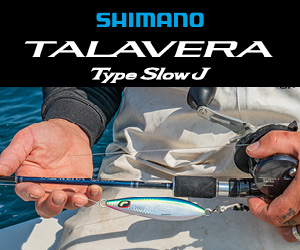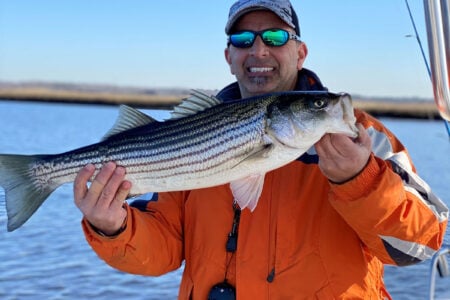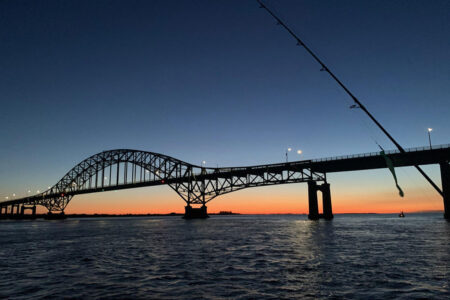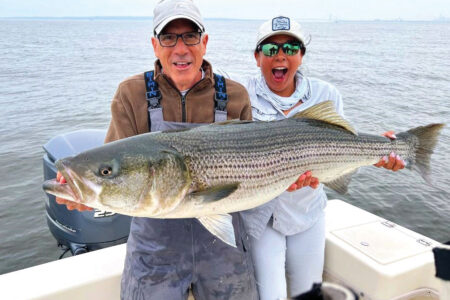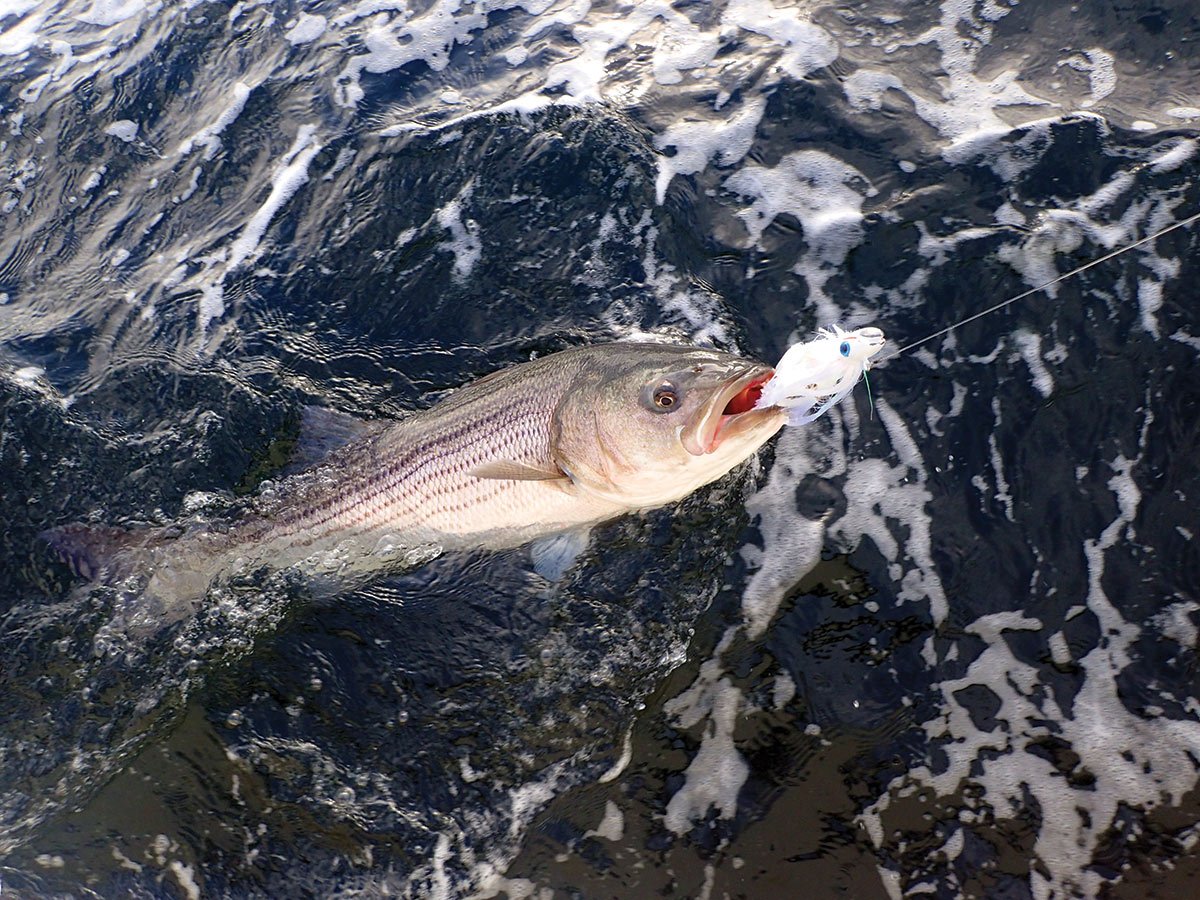
Simple yet effective, it’s a wonder why every striper angler hasn’t made the mojo leap.
Fishing mojos for striped bass is so effective that I have often referred to it as the “ultimate equalizer.” The fact is, anglers of all experience levels can use this tactic when striped bass are present to score a great catch without having to possess immense skills with the lures and vast experience in trolling. The mojo application can be categorized as “simple” considering that fishing can be, at times, quite complex.
While trolling, captains drop several single or tandem rigs to the bottom and when they touch, they simply make sure they rise or reel them up a few feet so they don’t drag or snag. The remaining lines, depending on the beam of the boat, are set out at different heights in the water column. There’s not too, too much more to it. Or is there? I’m not going to contradict my own proclamation of these lures being so darn good at catching that they level the playing field, but I will say that there are tips and nuances that make a difference when the bite is fickle.
Keep ‘em Clean
I’ve seen a lot of anglers troll for hours without checking their spread. The mojos don’t just catch fish, they pick up weeds, grass and junk such as plastics. This stuff tends to get hung up around the three-way swivel, the knot at the mojo, and the hook. Striped bass will not bite a mojo compromised in this manner.
Mojos traveling closer to the bottom will sometimes touch or drag when depths change over humps and slopes (which is why it can be a tricky tactic to employ along reefs and boulder strewn bottom). It’s best if captains continually monitor the rods if they see the mojo bumping along the bottom; this appearance will show in the rod’s tip stuttering and stumbling as the lead head noses into the sea floor. Mud bits and clusters get hung around the area where the knot is tied to the mojo and sometimes throughout the parachute.
In big bays and estuaries, the muddy bottom is often sticky and will not fall off without human removal. I try to check my lines every 10 minutes when the weeds or mud clusters are prevalent in a stretch of water. More subtle than mud getting married to the mojo is sediment that the parachute picks up in the water column. It’s particularly noticeable in the white skirts as the hair begins to change from a bright white color to a unit containing a tan or brownish look. The sediment effect takes more time and can be expected after hours of trolling.
I like to wash and cleanse the mojo on the spot, sometimes sifting and pulling the particles out. Freshwater can be more effective washing out the dirt. But sometimes it’s simply too much of a fight to clean lures as if they are my next day’s work attire while I’m trying to operate a boat and fish. In this event, I cut the mojos off, replace them and thoroughly wash them in my sink post-outing.
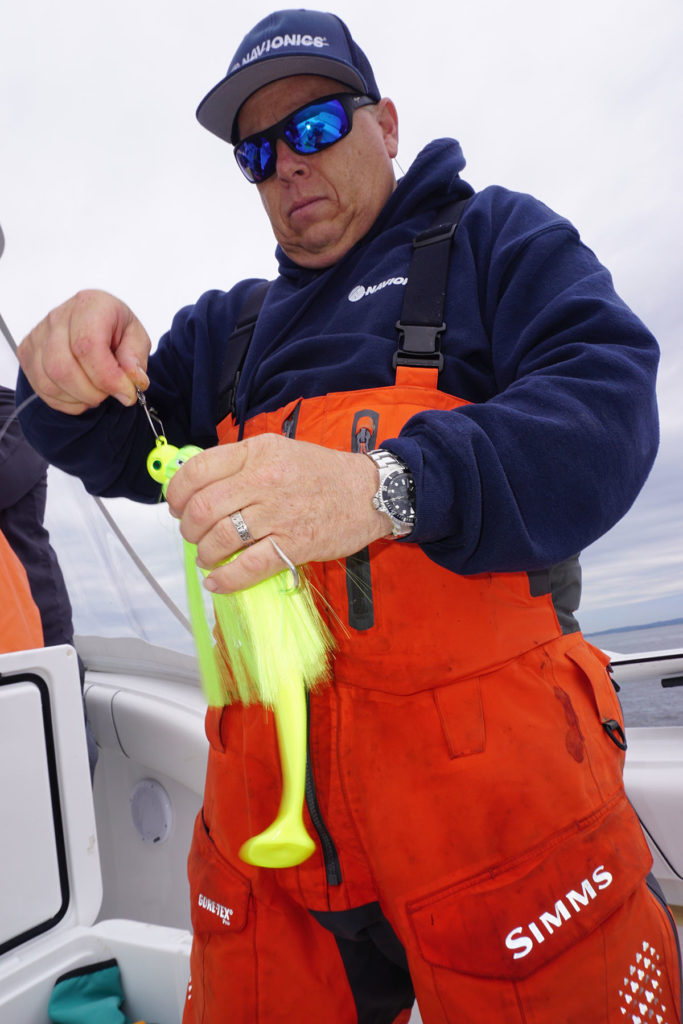
The mojo parachute isn’t the only item that gets dirty. The swim shads can lose their luster after being drug around multiple outings. Again, if the bite isn’t earth-shattering on a given day, this can be an area where anglers look to upgrade their presentation by attaching a fresh shad to the line. A dirty one can be rinsed, scrubbed and cleaned at home and potentially reused if doesn’t get ruined by taking it off the hook. If deemed toast, the shad can be trashed, or it can be saved for surface blitz fishing. I find that 6- and 9-inch shad bodies with a hook through the nose are fun to toss at feverish stripers and bluefish; if the bait gets trashed it’s no big deal as it was destined for the recycle bin anyway.
Although it has nothing to do with cleanliness, mojo parachutes have a habit of flipping hair strands over the leader line during deployment. Anglers that simply throw their rigs overboard without observation are at greatest risk of this. Clear any parachute strands and watch while setting out. As long as the boat pulls the plume back at the beginning of deployment, all should be good.
Shads & Speeds
It’s the flexible body that wobbles and wiggles within the parachute that drives bass nuts. Sometimes the paddle tails actually whip around enough that they can catch onto the stinger hook of the mojo. If this takes place more than once, it’s time to realign the shad in order to avoid a repeat occurrence. Likewise, when the hook starts to pull sideways out of the shad body and not the top, it often loses its winning appearance in the water and should be fixed or replaced. This happens after it’s been gobbled and twisted by hungry stripers or if a bass thrashes around the deck after being landed. Time is too valuable to troll lures that don’t run properly, which is why I try to make it a habit to check each rod periodically for problems at the hook.
As you can imagine, trolling speed is one of the most critical items to dial in. “Slow as you can go,” which has been chronicled and directed to beginner captains isn’t entirely accurate. Speed on the water due to engine and vessel variation is different for each boat. For example, there’s one Atlantic City-based captain that goes as slowly as he can and it’s still too fast, which is why he trolls 5-gallon buckets to drop the speed into his desired range. Generally, 3 to 4 mph is best depending on conditions. If I were to pick a speed I’ve succeeded most at, it would be 3.2 to 3.7 mph.
Not so fast (no pun intended); trolling into the tide and current as opposed to with it dictates that captains adjust. For instance, trolling straight into a heavy current will puff the parachutes and wiggle the paddle tails much more than trolling with a following sea. The rod tips will pulse nicely and, it will also cause the presentations to lift off the bottom more, which is especially true around moon tides. Then the right boat speeds can drop well below a standard threshold.
As simple as mojo fishing can be, adjustments and monitoring of surroundings are the order of each moment during an outing. When I’m fishing with friends trolling nearby and one of us “goes cold” on the fish, we’ll troll side by side. This way the slumping captain can check to make sure his speed is identical and that this detail is not the issue to not catching.
While fishermen are trolling through and around dense bunker schools, the braided line (I prefer 50-pound braid.) will vibrate rapidly as the line bounces off the baitfish. The gill plates on the menhaden are capable of doing damage to the braid and actually sometimes hang a bunker briefly. Periodically inspect the line to make sure its integrity is not lost. And be sure to instruct your crew to immobilize any fired-up fish brought aboard as they swing mojos around about the gelcoat. There is less chance the lead head will damage the boat!
One of the greatest attributes of hooking bass on mojos is that they rarely gut hook. I’d be willing to bet that this happens less than 3 percent of the time. And the fish that come onboard are always spirited and fresh thus ready for release. It’s something that anglers can’t help but feel good about when the mad dog bite is on, and everyone has an opportunity to reel.
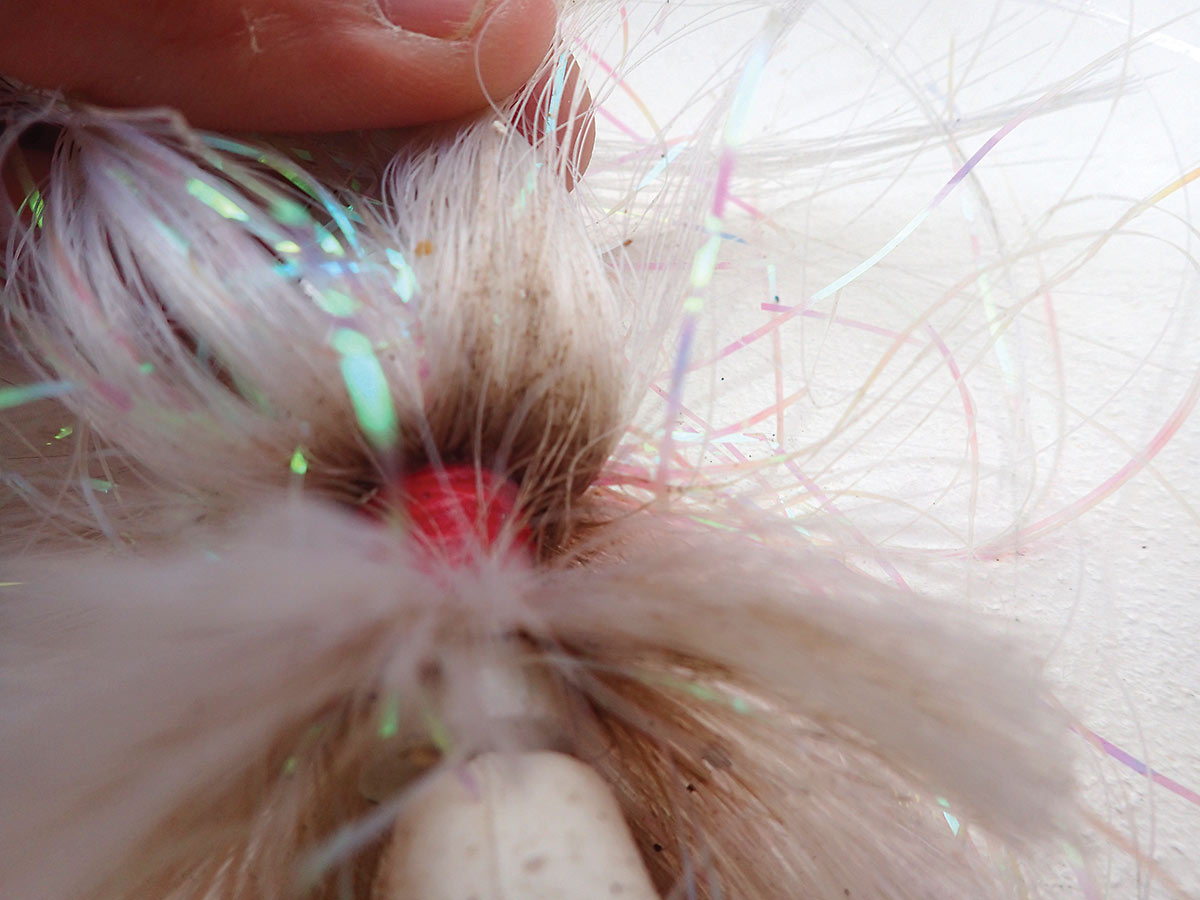 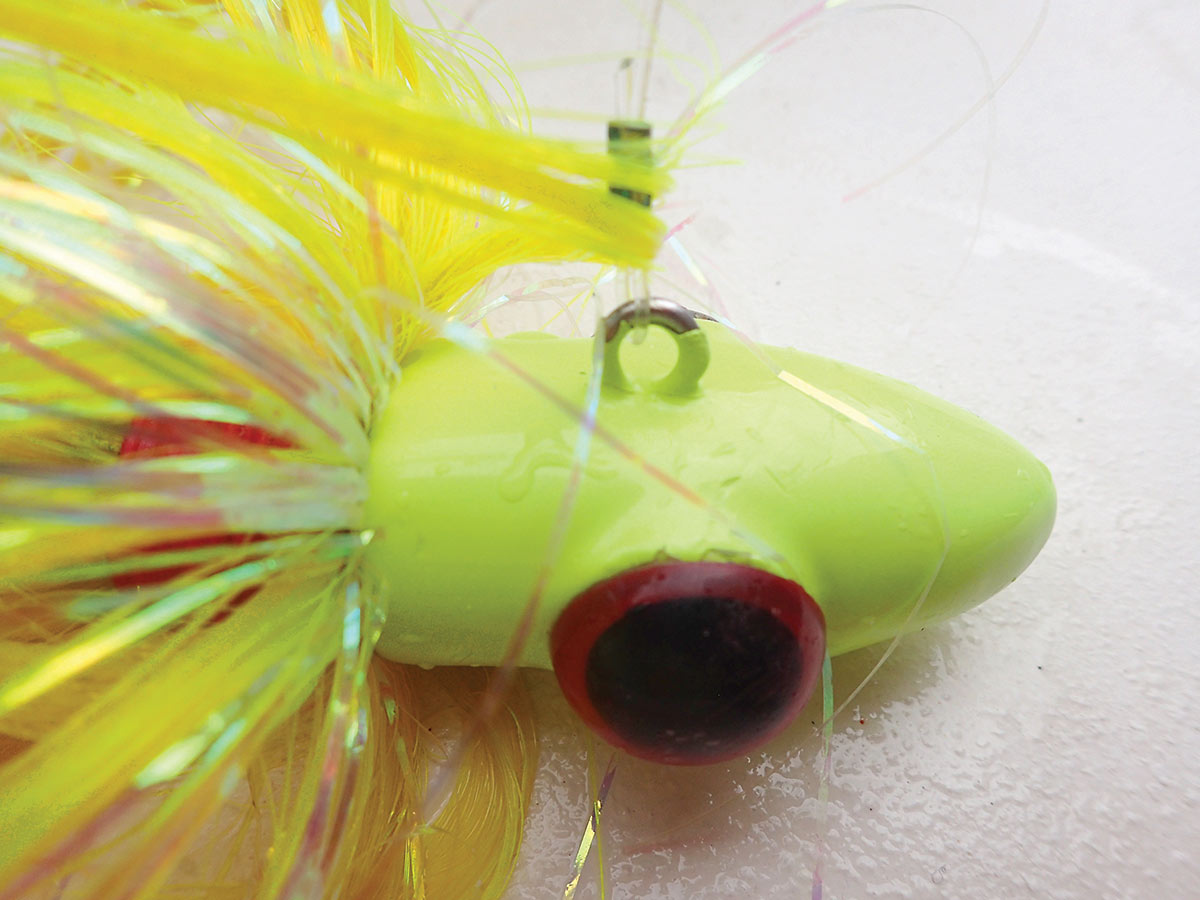 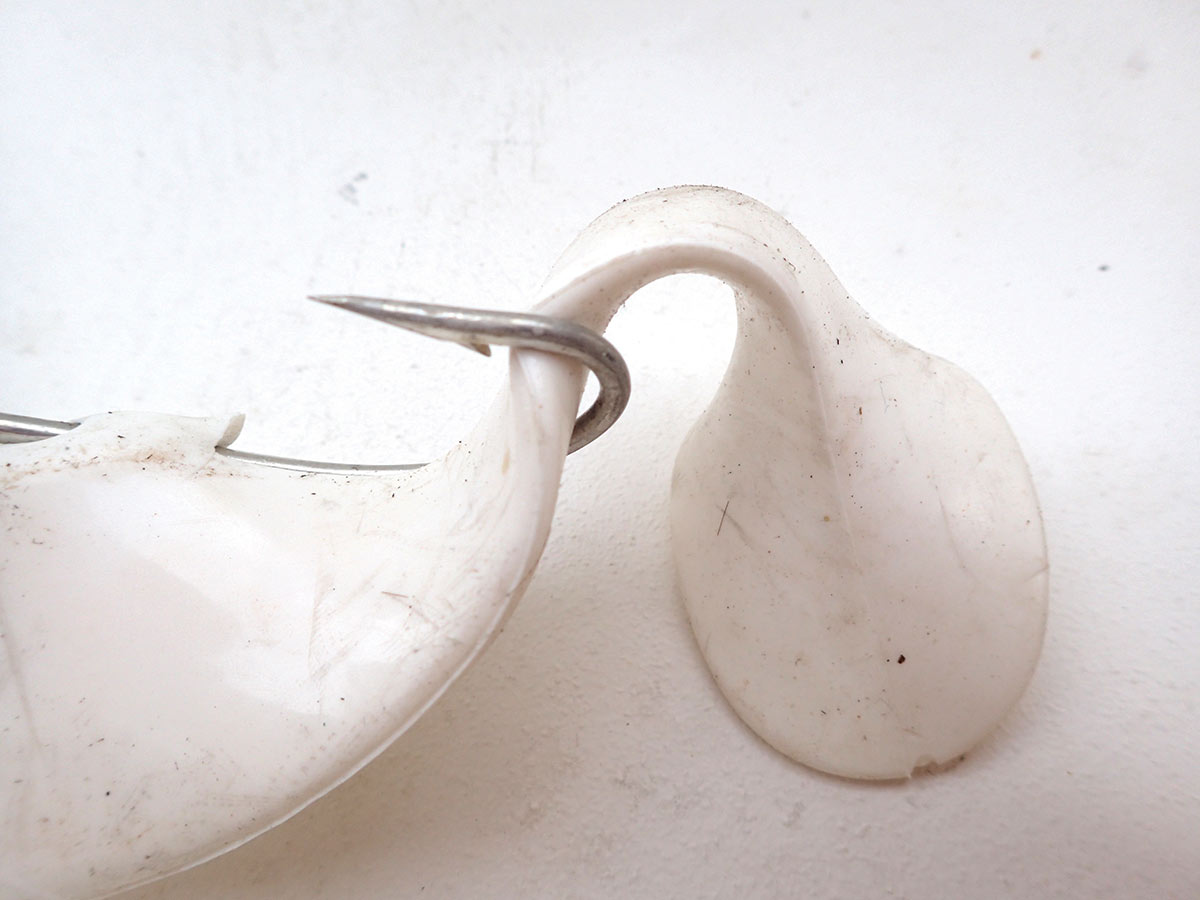 |
|---|
| Keep hairs of leadheads as clean as possible on the troll, even if it means freshwater washdown on the spot. Be sure to keep any parachute strands free from entanglement, and check shads periodically to ensure they’re not foul-hooked by the stinger. |
